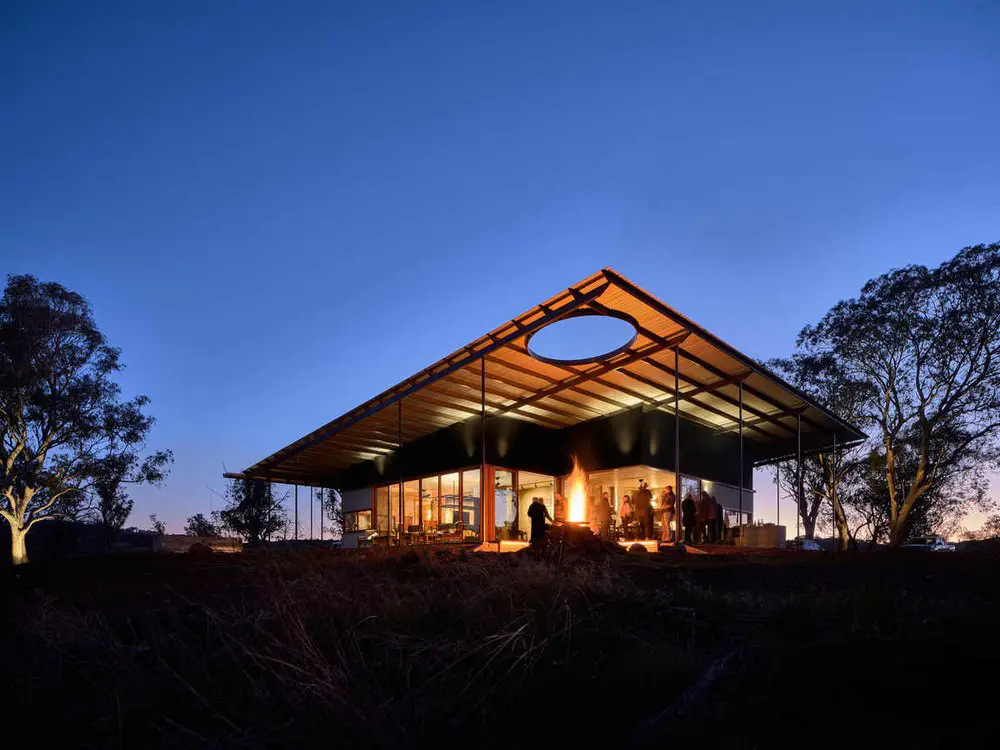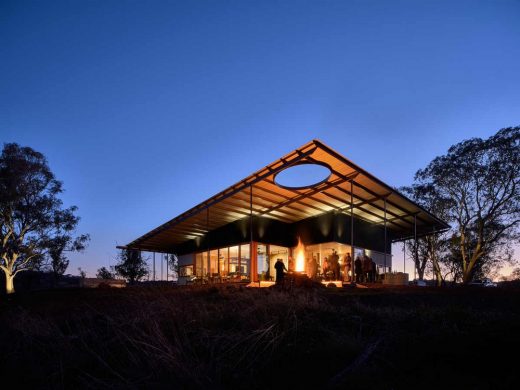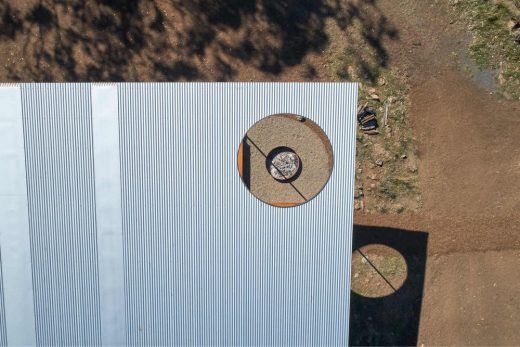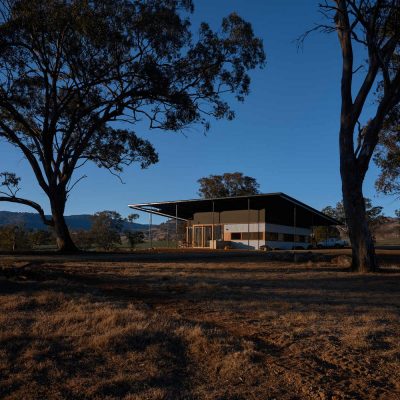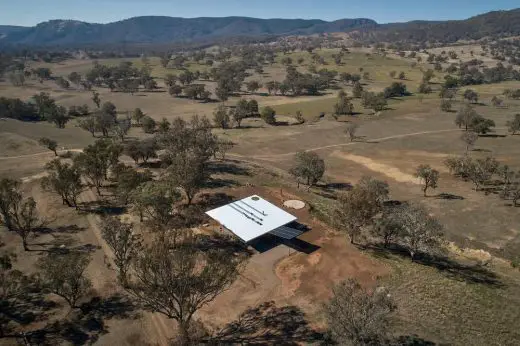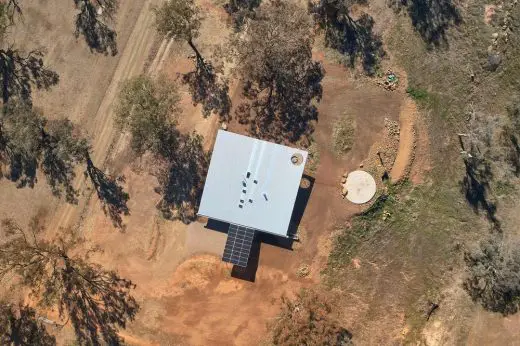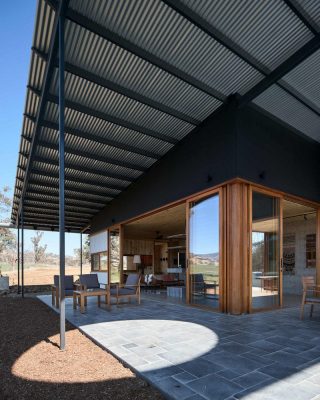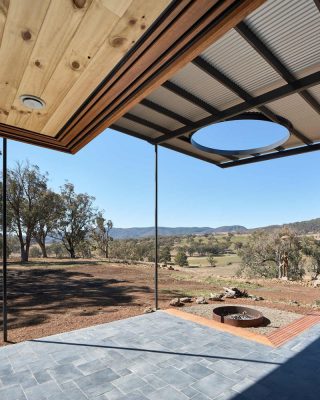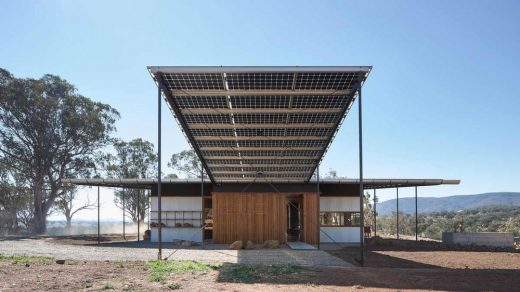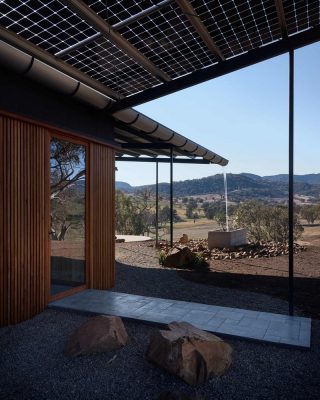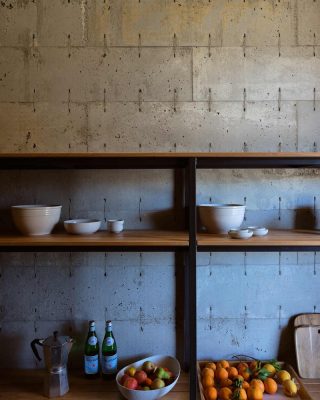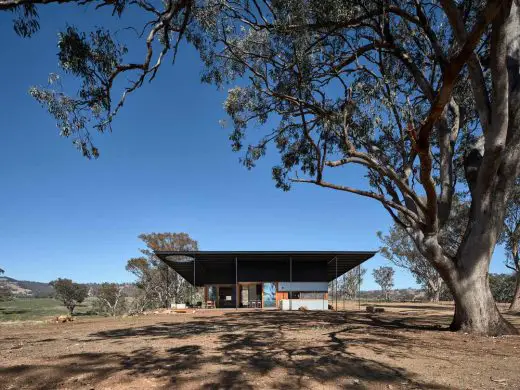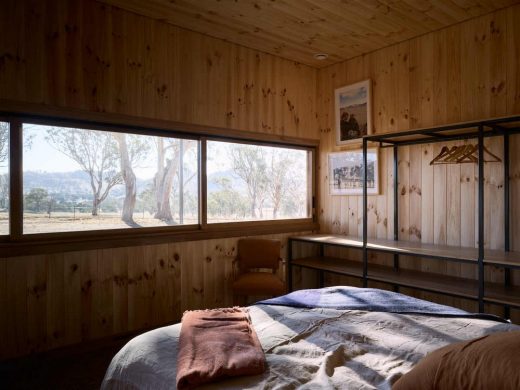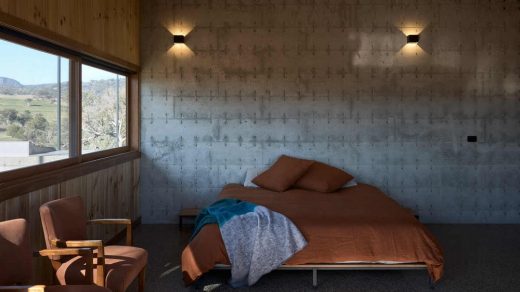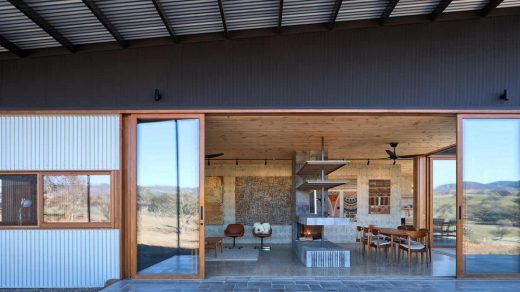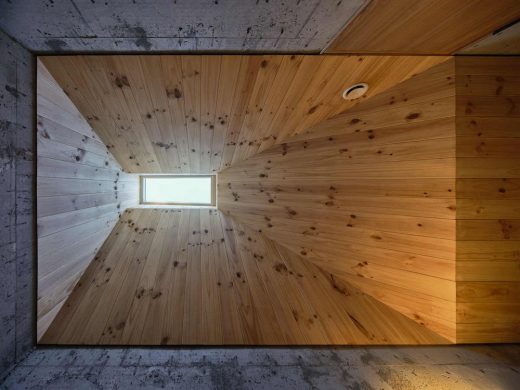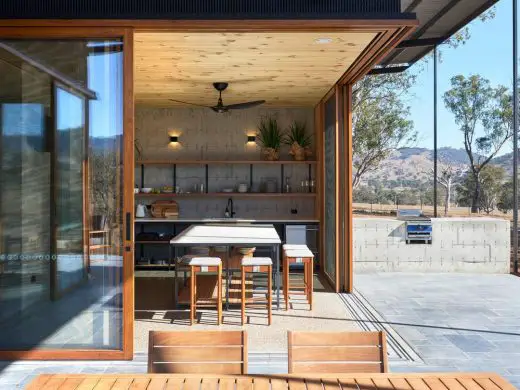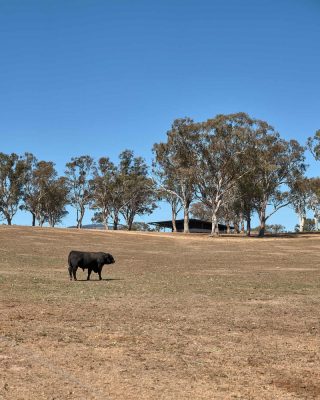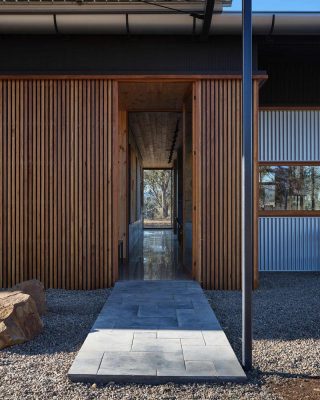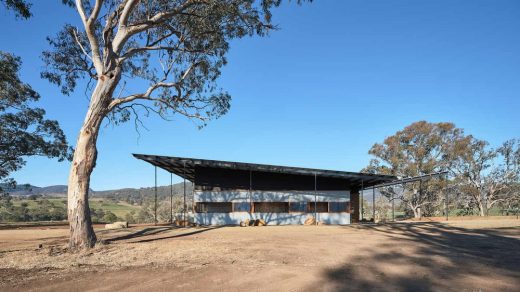Upside Down Akubra House in Nundle, NSW Sustainable Residence, Australian Home, Architecture Images
Upside Down Akubra House in Nundle, NSW
Sustainable Australian Real Estate, New South Wales House – design by ASA – Alexander Symes Architect
14 Nov 2019
Upside Down Akubra House
Design: ASA – Alexander Symes Architect
Location: Nundle, NSW, Australia
The Upside Down Akubra House is located in the middle of a bull paddock sits an off-grid home inspired by the iconic Australian Akubra hat.
This inspiration came about at the first meeting with the clients on their bull farm, around 50mins south east of Tamworth. The client had selected the site for their new home atop a gently sloping hill, amongst a grove of eucalypts, with the land falling sharply away to the east to a dry creek bed.
From this vantage point the clients pointed out the vistas they wanted to appreciate from their new home: “yella-rock” to the south, “hanging-rock” to the east, a unique vista north through the grove of native tress and a vista west, over the dusty bull paddocks to the rolling hills beyond. Essentially an amazing 360 degree view all the way around.
It was at this point that one of the key challenges for this project presented itself: how to create a low energy, thermally comfortable home that celebrated views all around. The station manager was curiously watching on, wondering what this city-slicker Architect was going to do, when I asked him for his Akubra hat.
Placing it upside down, I started to explain the concept of the “upside down Akubra house”. The idea being, a single large scale roof form, much like the brim of the Akubra hat, overhanging the house below.
The roof would block out all the summer sun, yet allow in the winter sun to warm the central thermal mass that would form the spine of the home as well as catching rainwater to run the house, all with a functional home underneath celebrating views in every direction.
From this meeting, the Upside Down Akubra House was born, a house with a roof that is 2.5 times the size of the building footprint, a home that generates and stores all its own energy and collects enough water to run the house and treat its own waste. Living off-grid is not new these days, but necessary in this remote location, greatly affected by extreme weather conditions including the current drought. What makes this off-grid home unique however, is how the technology has become the aesthetic of the home.
Celebrating the off-grid characteristics begins with the “humble” carport, although standing at 4.5m at the tallest point and covering an area of 80m2 this carport is far from humble. It is in fact a canopy of LG neon bi-facial photo-voltaics, which means that the solar cells are visible from the underside of the canopy celebrating the technology that powers the whole house.
Through exposing the solar panels this communicates to visitors the eco-technologies that are integrated into the design and educates all on low environmental impact power generation options and the efficient use of energy. The photo-voltaics generate 8KW of power for the house and are integrated into clear glass modules which allow filtered daylight into the car port, maintaining a connection to the sky in what is typically a closed off and dark space.
The entry to the home is also the introduction to the single 450mm diameter gutter that collects all rainwater off the 560m2 roof. This gutter, channels all the rainwater from the roof to a single point from which the water free falls like a waterfall into to a simple off-form concrete trough, which acts as a filtration sump which feeds the 107,000L rainwater storage tank.
Australia is the driest inhabited continent in the world and rainfall is the lifeblood of Australia’s farming community. By revealing a typically concealed process it communicates the importance of collecting and storing water that aims to encourage the efficient use of it.
Setting aside the technical elements of the entry, the first glimpse of how the house has been nestled into the unique natural surrounds is revealed at the air lock front door. The air lock is made up of two 3m tall blackbutt timber framed glass doors through which a clear view is created down the central off form concrete spine of the house and through to the grove of native eucalypts that cluster on the northern side of the house.
This moment brings the natural environment into the house blurring the lines between the inside and the outside which becomes an important theme throughout the house.
On stepping through the air lock, the home opens up into the open plan study, living and dining areas with the simplicity and openness of the space allowing the eye to be drawn to the impressive vista to Hanging Rock, framed by the 3m tall blackbutt double glazed sliding doors with high visual light transmittance.
The 3m tall sliders are flanked by a series of smaller horizontal windows that form a common datum line around the house. These windows focus the view to the horizon and “yella-rock” beyond making you feel part of the landscape. The use of double glazed, high visual light transmittent glass throughout the house contributes to the thermal comfort of the occupants throughout the year whilst allowing a high level of natural light to flood into the home.
The central spine of the house contains the utility and service rooms and is bounded by a textured off-form concrete wall created from the imprint of the zego reusable formwork solution. This blank canvas offers a simple backdrop to the owner’s indigenous art collection which is displayed throughout.
Following this spine towards the view you come to the open plan kitchen which flows seamlessly to the outside bluestone patio that wraps around the northern and eastern elevations. The kitchen is anchored by the large island workbench which allows the communal preparation of meals and the coming together of friends and family.
The bluestone patio is ample in size creating outdoor rooms that extend the inside out and provides additional opportunities to gather and feel connected to the land. This is accentuated by the progressive view to Hanging Rock that is framed by the cantilevering corners of the roof that connect the internal living spaces to the outdoor rooms coupled with the layering of the fire pit with the horizon to create a dramatic backdrop to the main living spaces.
The west wing of the house contains the modest bedrooms which have a low window to wall ratio to provide privacy and most importantly improve the thermal performance of these spaces in the harsh western sun. The windows follow the line of the horizon framing the views across the paddocks to the escarpment. This deliberate horizontal datum also slowly reveals the house to visitors as they approach on the western driveway that wraps around the house.
The home is influenced by simple practical rural buildings which inform its metal, timber and concrete material palette, responding to the clients brief for a robust and practical house. This manifests itself in a house that is “dematerialised”, with exposed joinery, polished concrete floors and exposed concrete walls.
The joinery throughout is open shelved black steel and blackbutt decking boards with pine lining boards for the walls. The pine boards also line the ceilings throughout and are used in the utility spaces to accentuate the view upwards to the operable skylights which bring in natural ventilation and enable a connection to the sky in these inward facing rooms.
The floor is polished concrete with an aggregate that reflects the warm colours of the land and the greens of the bush. Integrated in the floor is in-slab hydronic heating and cooling which is powered by onsite renewables and provides additional active heating and cooling as necessary.
The concrete floors together with the zegoform concrete walls are exposed in winter due to the pitched roof form and covered in summer, when the sun is high, thus creating a large thermal mass through the house which provides natural warmth in winter and natural cooling in summer.
This simple palette continues to the exterior with the lower portion of the home clad in reflective zinculume custom orb which picks up the sun, illuminating the home in the landscape. The upper portion of the façade is clad in monument matte mini-orb which makes the structure and roof recede, emphasising the floating “Akubra” roof.
This simple black and white exterior colour palette is broken up by blackbutt timber on the windows, door frames and screening for the utility areas, providing moments of warmth which soften the exterior and nestle the house into the landscape.
To further manage the extreme temperatures during the year the façade and roof are highly insulated and sealed with a high-performance water permeable membrane increases air-tightness. To assist in providing fresh air to all the rooms without losing or gaining unwanted heat the ceiling void is fitted with a heat recovery ventilation unit which circulates fresh air to all the rooms and is fitted with a heat exchanger which reduces the energy losses.
Through the inspiration of the iconic Akubra hat a simple, yet modern farmhouse is created. One that responds to the extreme climatic conditions, has a light touch on the landscape, harnessing natures energy for sufficiency and connects to the surrounds on which it stands.
The brief was to design a 3 bedroom home that celebrated the sites panoramic views focusing on hanging rock and yella-rock. The home must be robust, practical and low maintenance. The home needed to be capable of entertaining family and friends with an outdoor fire-pit and opportunities to display artwork.
Due to the clients desire to celebrate the 360 degree panoramic views it was going to be difficult to design a solar passive house. The solution was to strategically focus the larger windows on the living room views and reduce the glazing to the bedroom areas.
By designing a large sunshade around the building to block-out direct summer solar radiation and allow in direct winter solar radiation to reach the exposed insulated thermal mass concrete floor and walls the design is able to get natural heating in winter and natural cooling in summer.
The sites remoteness required that all services needed to be generated onsite. Therefore all waste had to be treated onsite via an onsite waste water treatment system; all water had to be captured onsite and stored in a 107,000 litre rainwater tank; and all energy need to be generated onsite by an 8KW photovoltaic system with batteries and a generator back-up.
Upside Down Akubra House, NSW – Building Information
Design: ASA – Alexander Symes Architect
Project size: 195 sqm
Site size: 3140000 sqm
Project Budget: $0
Completion date: 2019
Building levels: 1
Project team:
Builder: Blue Eco Homes
Structural Engineer: Ascent Consulting Engineers
Key products used:
LG Neon bi-facial solar panel
Zego Reform off form concrete walls
Pyrolave worktops
Colourbond custom orb and miniorb
Ecooutdoor pacific bluestone
Chazelles D1000 EPI fireplace
Eziform gutter
Proclima extasana water permeable membrane
Stormtech strip drains
Bigassfans ceiling fans
Brink Heat Recovery Ventilation system
Velux skylights
Ozzi Kleen RP10 wastewater treatment system
Viridian lightbridge insulated glass units
Sustainability Features:
Exposed insulated thermal mass shaded in summer and exposed in winter.
Heat recovery ventilated system.
Onsite wastewater treatment system.
In-slab Hydronic heating and cooling powered by onsite renewables.
Rainwater collection and 107,000 Litre storage.
Timber window and door frames with low conductivity.
High performance double glass with high visual light transmittance.
Timber framing, glazing, joinery and linings.
Evenly distributed daylight.
Low air infiltration building envelope with water permeable membrane, tested and commissioned by blower door test.
Ceiling fans for thermal comfort in summer.
Photography: Barton Taylor
Upside Down Akubra House in Nundle, NSW images / information received 141119
Location: Nundle, South Coast, New South Wales, Australia
New Sydney Architecture
Contemporary Sydney Property
Sydney Architectural Designs – chronological list
Architecture Walking Tours in Sydney by e-architect
Bellevue Hill House
Architecture: Geoform Design Architects
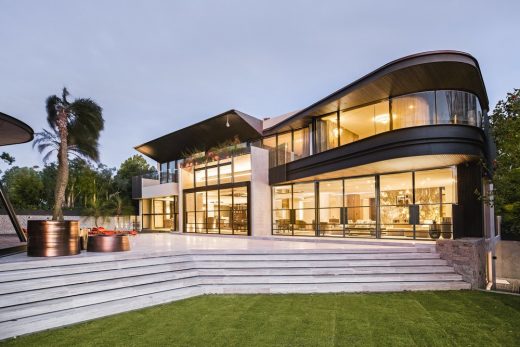
photograph : Kate Stanley
Bellevue Hill House
Design: SAOTA and TKD Architects
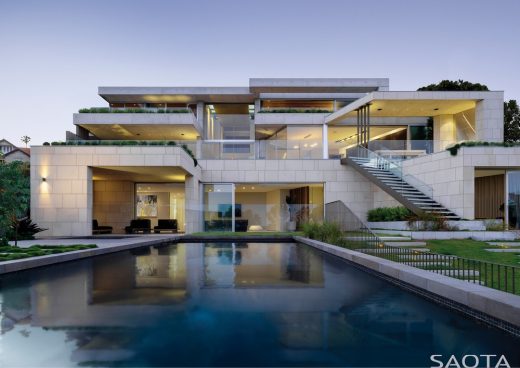
photograph : Justin Alexander
Mosman House
Architecture in Australia
Architects: anthrosite
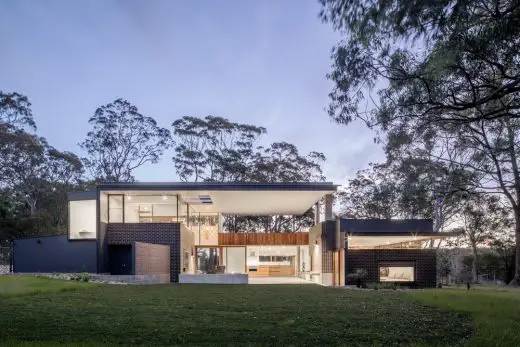
photo : Jon Reid
Contemporary House in Newcastle, NSW
Australian Architect Offices : Studio Listings
Comments for the Upside Down Akubra House in Nundle, NSW page welcome
Website: NSW

